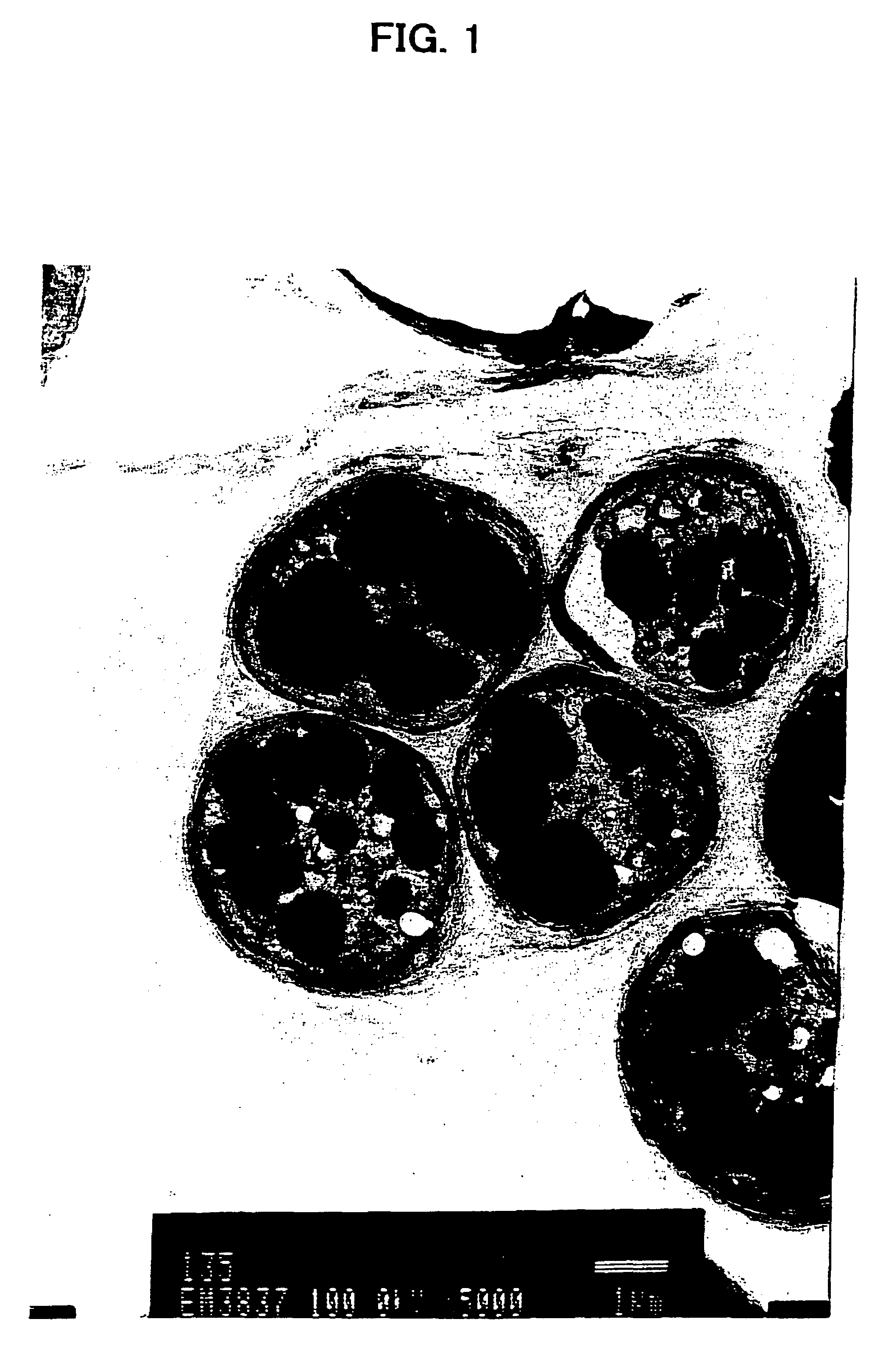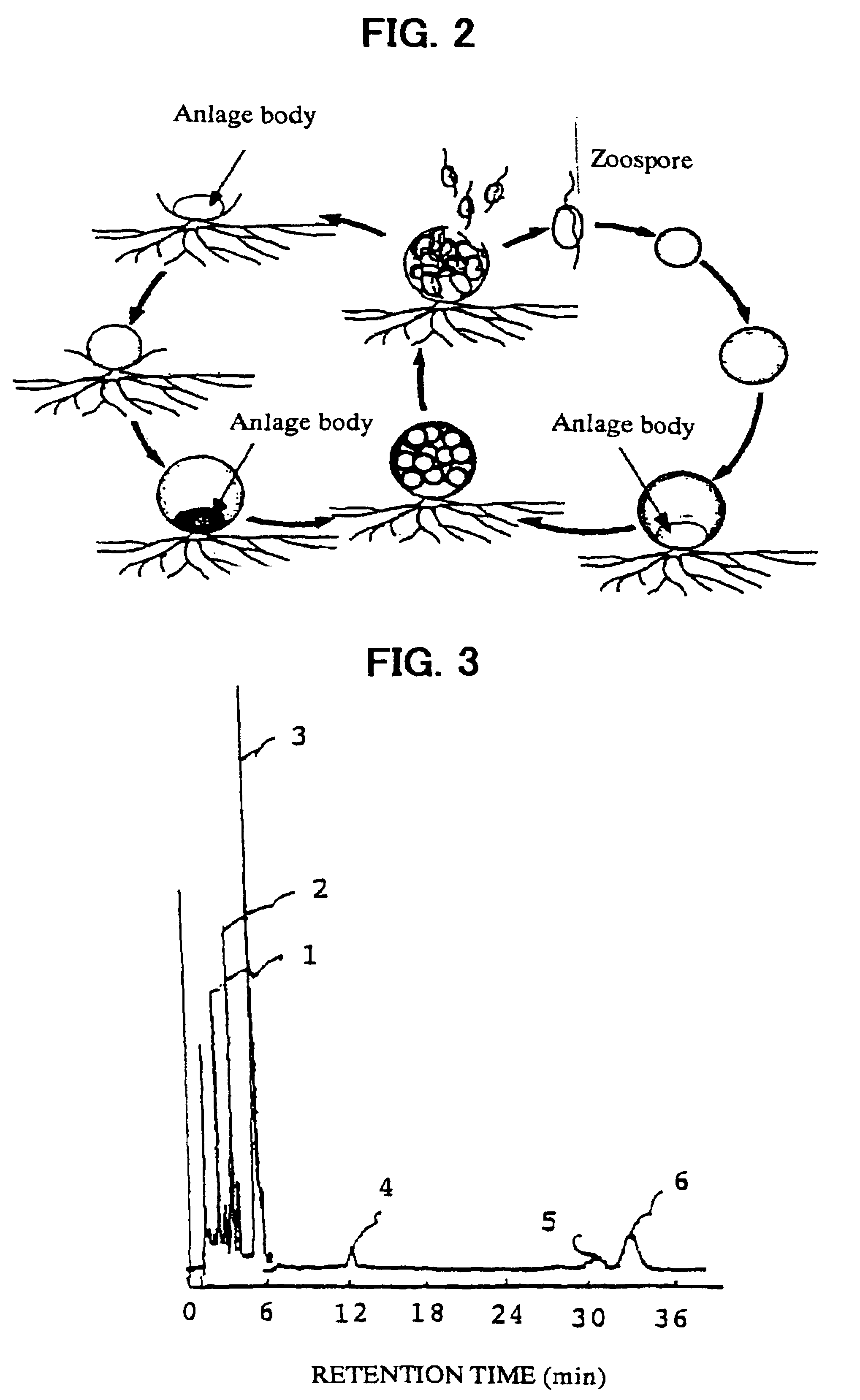Microorganism and production of carotinoid compounds thereby
a technology of carotinoid compounds and microorganisms, which is applied in the field of microorganisms and production of carotinoid compounds thereby, can solve the problems of not being suitable for industrial production, difficult to extract the compound, and low content of the compound in the body of these animals, and achieves simple and efficient large-scale production.
- Summary
- Abstract
- Description
- Claims
- Application Information
AI Technical Summary
Benefits of technology
Problems solved by technology
Method used
Image
Examples
example 1
[0057]Pure Thraustochytrium species CHN-3 purified from Thraustochytrium species CHN-1 collected by suspending the pollens of Pinus thunbergii in seawater sampled from the coast of Nagahama district of the seacoast of the Inland Sea of Japan was inoculated to a saccharic culture medium (pH 5.0) containing 60 g / liter of glucose, 1 g / liter of peptone, 1 g / liter of potassium dihydrogen phosphate and 1 g / liter of phosphorus as phosphate ions in seawater. The cells were cultured at a temperature of 28° C. for 6 days under aeration with stirring while a white light (the light from a fluorescent lamp) is irradiated at an intensity of 1000 lux. The culture solution obtained was centrifuged to collect the cells of the microorganism. The electron microscopic photograph of the cells obtained as described above is shown in FIG. 1.
[0058]The cells were extracted with acetone, chloroform and methyl alcohol, and the extract was passed through a column filled with silica gel (trade name Wako gel, ma...
example 2
[0061]Thraustochytrium species CHN-3 was cultured at a temperature of 23° C. for 6 days using a culture medium containing 50 g / liter of glucose, 1 g / liter of peptone and 1 g / liter of potassium dihydrogen phosphate in seawater under the following conditions; (a) rotation-vibration culturing at 100 rpm under a white light illumination at an illuminance of 1000 lux, (b) rotation-vibration culturing at 100 rpm in dark, (c) static culturing at an illuminance of 1000 lux, and (d) aeration culturing with stirring at an illuminance of 1000 lux. The results are shown in Table 1.
[0062]
TABLE 1Culture condition(a)(b)(c)(d)Prod-Astaxanthin0.8-1.00.2-0.50.1>1.0-1.8ucts(mg / g drycells)Biomass2.01-2.621.37-1.460.26-0.392.46-3.10(g drycells / litter)
[0063]Table 1 shows that substantially no astaxanthin is produced by static culturing. Light irradiation affords more astaxanthin in rotation-vibration culture. The yield of astaxanthin could be increased as much as 1.8 times by increasing the oxygen concen...
example 3
[0064]Culturing was continued for 14 days by the same test culturing as in Example 1, except that the pH of the sugar-rich culture medium used in Example 1 was changed using aqueous hydrochloric acid solution and aqueous sodium hydroxide solution, and productivity of astaxanthin at each pH was determined. The results are shown in the graph in FIG. 4. The graph shows that the productivity of astaxanthin increased, as the pH was increased.
PUM
| Property | Measurement | Unit |
|---|---|---|
| wavelength | aaaaa | aaaaa |
| wavelength | aaaaa | aaaaa |
| size | aaaaa | aaaaa |
Abstract
Description
Claims
Application Information
 Login to View More
Login to View More - R&D
- Intellectual Property
- Life Sciences
- Materials
- Tech Scout
- Unparalleled Data Quality
- Higher Quality Content
- 60% Fewer Hallucinations
Browse by: Latest US Patents, China's latest patents, Technical Efficacy Thesaurus, Application Domain, Technology Topic, Popular Technical Reports.
© 2025 PatSnap. All rights reserved.Legal|Privacy policy|Modern Slavery Act Transparency Statement|Sitemap|About US| Contact US: help@patsnap.com



